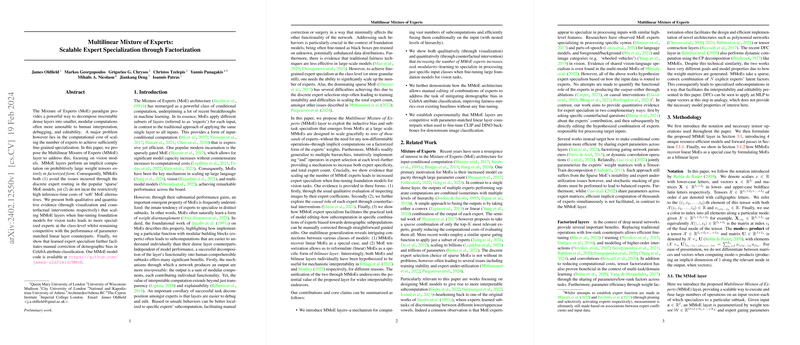Enhanced Specialization and Interpretability in Vision Models with Multilinear Mixture of Experts
Introduction
The Mixture of Experts (MoE) architecture has been instrumental in advancing machine learning models by allowing different subsets of layers, or "experts", to process inputs, thereby enabling more expressive and efficient computations. Despite the success of MoEs, scaling the number of experts to enhance model capacity and specialization faces significant challenges. High computational costs, training instability, and difficulty in scaling the expert count have limited the practical applicability of MoEs, especially in sparse configurations. Addressing these challenges, this paper presents the Multilinear Mixture of Experts (MMoE) layer, engineered for scalable expert specialization in vision models through a comprehensive factorization approach.
MMoE: A Path to Scalable Expert Specialization
MMoE layers leverage factorized weight tensors, facilitating the implicit computation of large numbers of experts without the need for dense weight matrices or non-differentiable operations. This design not only mitigates the computational expense associated with traditional MoE models but also fosters expert specialization by allowing for tens of thousands of experts to operate within a tractable computational framework. The MMoE model encapsulates both increased expert specificity and hierarchical structure, making it adept at dealing with complex, hierarchical data.
Empirical Validation
Through extensive experimentation, the MMoE architecture demonstrates significant advances in task modularity and expert specialization. Utilizing qualitative visualizations alongside quantitative counterfactual interventions, the paper provides evidence that increasing the number of MMoE experts leads to a marked improvement in model performance on vision tasks. Specifically, it is shown that MMoE-enhanced foundation models for vision tasks achieve competitive performance metrics while facilitating a greater degree of interpretability and editability compared to conventional approaches.
Practical Implications and Future Applications
In practice, the MMoE model’s ability to decompose complex computations into understandable subtasks significantly aids in debugging, editing, and understanding model behavior. This characteristic is especially valuable in mitigating demographic biases in attribute classification tasks, as demonstrated through manual corrections in CelebA attribute classification. Looking forward, the paper suggests the potential for MMoE layers to serve as a foundational component in developing highly modular, interpretable, and efficient models across a broad spectrum of machine learning applications, extending beyond vision tasks to domains like natural language processing and multimodal learning.
Conclusion
The introduction of the Multilinear Mixture of Experts layer addresses critical challenges in scaling MoE architectures, offering a pathway to enhanced expert specialization without the computational overhead typically associated with such endeavors. By demonstrating the viability of MMoE layers in promoting interpretability, editability, and reduced demographic bias in machine learning models, this work contributes significantly to the ongoing pursuit of building more comprehensible and controllable AI systems. As this domain continues to evolve, the MMoE framework stands to play a pivotal role in shaping the future of AI, where transparency and efficiency are paramount.
